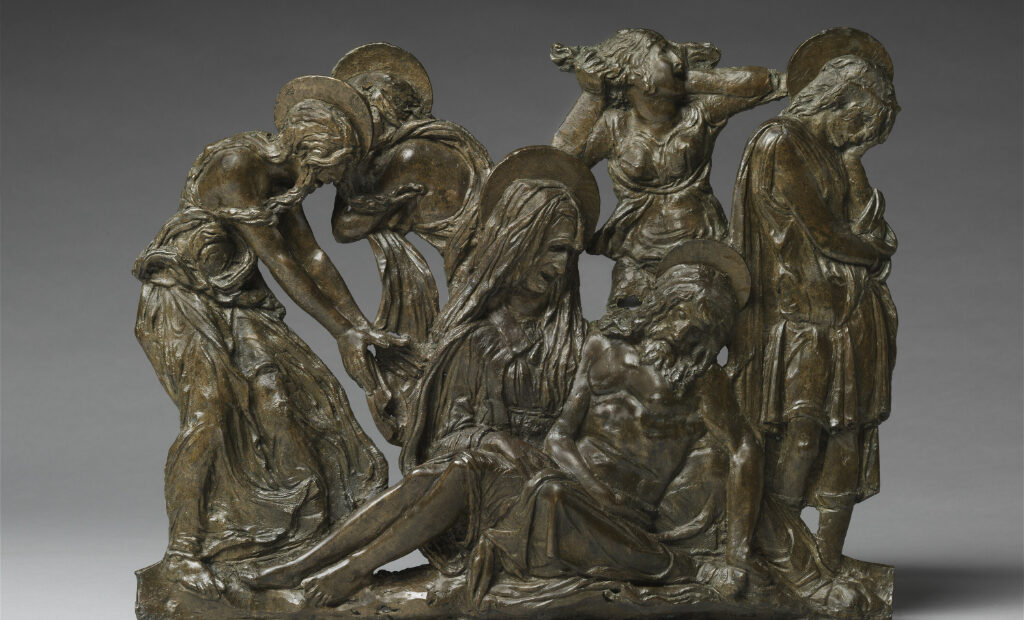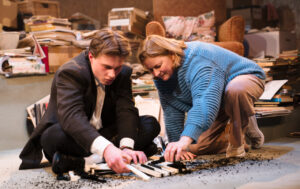Donatello: Sculpting the Renaissance at the V&A

As you walk into the exhibition rooms for Donatello: Sculpting the Renaissance at the Victoria and Albert museum in London, your attention is immediately drawn to a white, draped Roman-esque marble figure, one hand on his waist and head at a proud, slightly inquisitive angle. This is David (1408-9), a biblical sculpture originally intended for Florence Cathedral, which has never been seen in the UK before. Surrounding David are grey and blue walls, church-like domed “windows” showing later parts of the display, and collections of sculpture by Donatello, his students and contemporaries. Donatello: Sculpting the Renaissance is the UK’s first major exhibition to explore the work of renaissance sculpture and includes artworks never previously seen on British shores.
Donatello has been described as the greatest sculptor of all time, and from looking at his work you can see why. The attention to detail, from the folds of cloth and each individually crafted toe to the bulges of calf muscle, and the character and emotion on the faces, is extraordinary. This six-section show traces Donatello’s career from his Florentine foundations and the friendships and rivalries he experienced as a younger man, to the Tradition and Innovation room which highlights Donatello’s contributions to the lifelike busts of antiquity and contemporary figures. Bust of a man (1455-60), which may have been made by Donatello, stands out for capturing the essence of this regular man, not gilded in gold but draped in terracotta, his high cheekbones and calm, pious face creating a sense of warmth and comfort.
The design layout – with the domed cloisters and dim lighting – feels like walking around a church, which is fitting both given the biblical references in Donatello’s work and the aim of this display as a celebration of the late master. As would be expected of the time, Donatello worked a lot with biblical figures and focused heavily on the virgin and child. Virgin and Child (Pazzi Madonna – Donatello, 1420-25) is a carefully carved marble portrait depicting an intimate scene of a loving virgin holding her mischievous, almost imp-like baby which is an interesting and fresh take on the baby Jesus. The lighting is carefully arranged to create a “halo” effect around these sculptures.
In addition to Donatello’s own pieces and work with unknown origin (Donatello was sculpting in the 1300 and 1400s, and whilst much of the work is in immaculate condition, their history is less clear), we are also shown that of his contemporaries and those who would have assisted him and learned from him in the studio. The forehead lines, lion-like curls and cheek folds in the repousse copper, gilded and silvered God the Father by Beltramino de Zuttis da Rho is especially eye-catching. This collection contains a range of marble, bronze, wood, terracotta and stucco, as well as sketchbooks, work benches and the ornate marble Sarcophagus of St Justina (1476) from the workshop of Gregorio di Allegretto, with its perfectly carved nose, detailed hands and folds and cherub-like sprite angel on the side.
In the Bronzes: Sacred and Secular section, we are greeted with a short film which shows how these sculptures are made. Clay is rolled out like the decoration of a cake, creating curls and figures, while the marble is carefully and precisely sketched out and then chipped in, creating impressively ornate and detailed designs. Finally, in Homage to Donatello we hear about the history of the artist’s influence, from the followers who finished his works to the copycat sculptures he inspired in the 19th century, which were sold as original Donatello forgeries. This is a unique aspect of this show, and invites the viewer to consider the changing influence and legacy of works attributed to Donatello.
Despite his many contributions to art in the 14th century and far beyond, Donatello isn’t a regular household name in the way Picasso, Monet and Van Gogh are. This exhibition is a wonderful introduction and in-depth study, not just of Donatello, but of the art of sculpture, how it’s made and the many people living 700 years ago who made massive contributions to it. Sculpture can feel overlooked, confined to churches and historical cities, but it is an art form in its own right – and it should be celebrated.
Sophia Moss
Donatello: Sculpting the Renaissance is at the V&A from 11th February until 11th June 2023. For further information visit the exhibition’s website here.


























Facebook
Twitter
Instagram
YouTube
RSS